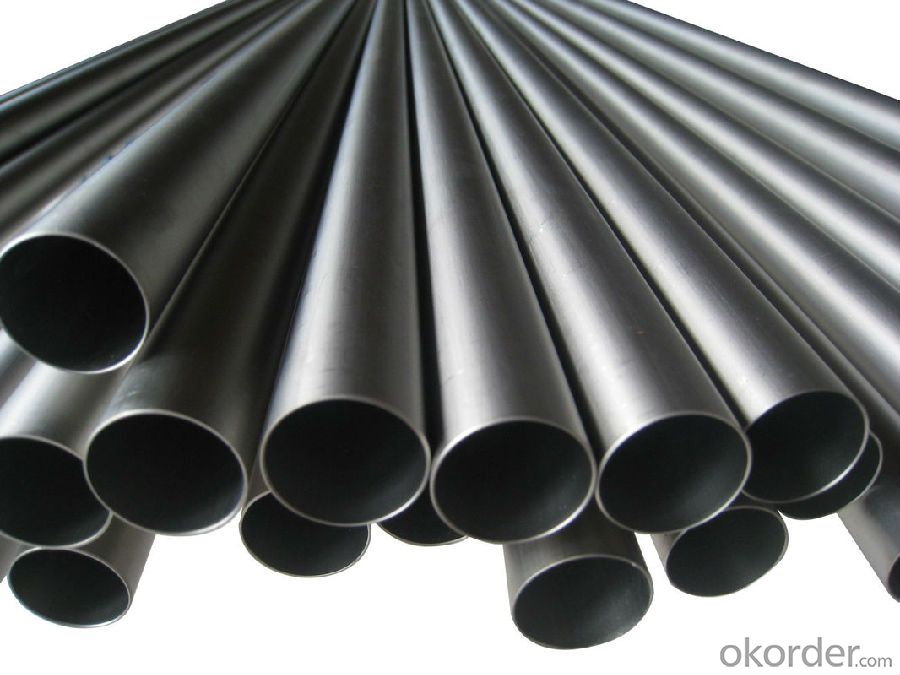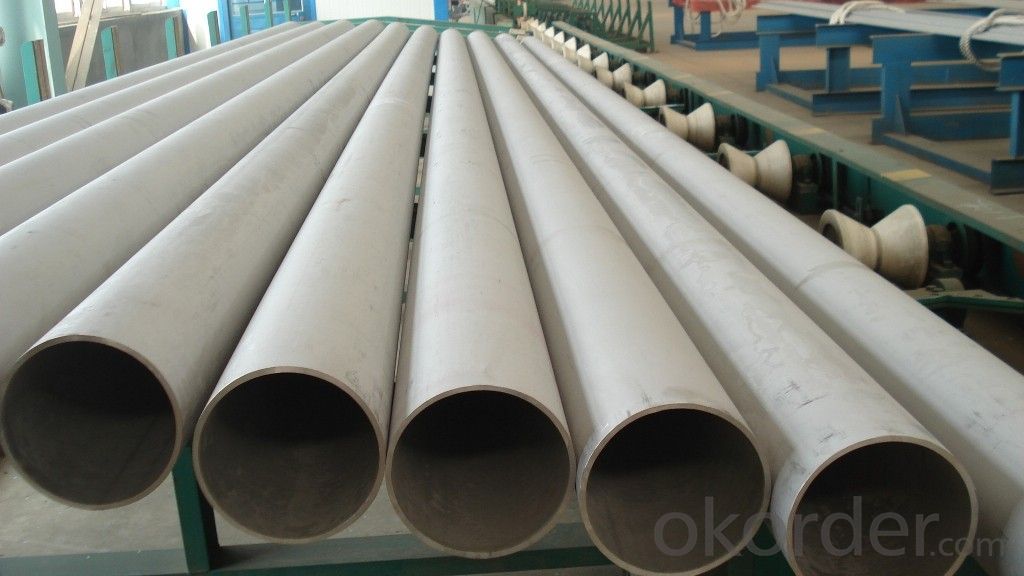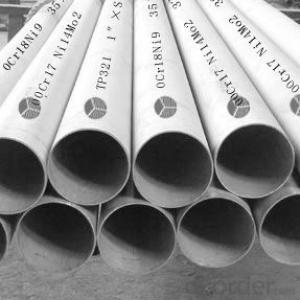Stainless Duplex Seamless Steel Pipe High Nicke 31803
- Loading Port:
- Ningbo
- Payment Terms:
- TT OR LC
- Min Order Qty:
- 1 m.t.
- Supply Capability:
- 5000 m.t./month
OKorder Service Pledge
OKorder Financial Service
You Might Also Like
1、Structure of Duplex steel A790 31803 seamless pipe Description:
Stainless steel is a production which not easy rust,acid resistance and corrosion resistance,so it is widely used in light industry,heavy industry,daily necessities and the decoration industry.my company long-term supply stainless steel porducts including:stainless steel sheet,stainless steel coil and stainless steel tube.
2、Main Features of Duplex steel A790 31803 seamless pipe:
• High manufacturing accuracy
• High strength
• Small inertia resistance
• Strong heat dissipation ability
• Good visual effect
•Reasonable price
3、Duplex steel A790 31803 seamless pipe Images:



4、Duplex steel A790 31803 seamless pipe Specification:
1. Process: Cold Rolling/ Cold Drawn
2. Size: 10mm-480mm
3. Standards: ASTM A312, ASTM A213, ASTM A269, DIN 2462, JIS G3463
4. Schedules:1mm-30mm
5. Material: TP304, TP304L, TP316L, TP321, TP317L, TP310S, TP347H, duplex steel
6.Surface Treatment: polishing, sand blasting,annealing and acid pickling
7.Package: export package (weaving bag ,non-fabric ,wooden case)
| process | size | standard | schecules | material | surface | package |
cold drawn/ cold rolling | 10-480mm | A312 A213 A269 etc. | 1-30mm | 304/321/316 310/317/347 duplex steel
| polishing annealing and pickling
| weaving bag in bundle plywood case |
5、FAQ of Duplex steel A790 31803 seamless pipe:
①How is the quality of your products?
Our products are manufactured strictly according to national and internaional standard, and we take a test
on every pipe before delivered out. If you want see our quality certifications and all kinds of testing report, please just ask us for it.
Guaranteed: If products’ quality don’t accord to discription as we give or the promise before you place order, we promise 100% refund.
②How about price?
Yes, we are factory and be able to give you lowest price below market one, and we have a policy that “ for saving time and absolutely honest business attitude, we quote as lowest as possible for any customer, and discount can be given according to quantity”,if you like bargain and factory price is not low enough as you think, just don’t waste your time.Please trust the quotation we would give you, it is professional one.
③Why should you chose us?
Chose happens because of quality, then price, We can give you both.Additionally, we can also offer professional products inquiry, products knowledge train(for agents), smooth goods delivery, exellent customer solution proposals.Our service formula: good quality+good price+good service=customer’s trust
SGS test is available, customer inspection before shipping is welcome, third party inspection is no problem.
Any question, pls feel free to contact us !
- Q:What is the difference between 304J7 and 316J7 stainless steel pipes?
- The main difference between 304J7 and 316J7 stainless steel pipes lies in their composition and properties. 304J7 stainless steel is part of the 304 series, which is a widely used stainless steel grade known for its excellent corrosion resistance and durability. It contains around 18-20% chromium and 8-10% nickel, which contribute to its corrosion resistance and make it suitable for various applications, including plumbing, food processing, and chemical industries. On the other hand, 316J7 stainless steel belongs to the 316 series, which is a higher grade of stainless steel compared to 304. It contains a higher amount of chromium (16-18%) and nickel (10-14%) as well as the addition of molybdenum (2-3%), which further enhances its corrosion resistance, especially against chlorides and other aggressive environments. This makes 316J7 stainless steel pipes ideal for applications such as marine environments, coastal areas, and chemical processing plants. In terms of mechanical properties, 316J7 stainless steel pipes generally have higher tensile strength and creep resistance compared to 304J7. This makes them more suitable for high-pressure and high-temperature applications. Furthermore, 316J7 stainless steel pipes are often considered more expensive than 304J7 due to their superior corrosion resistance and enhanced properties. However, the specific pricing may vary depending on market conditions and other factors. In summary, while both 304J7 and 316J7 stainless steel pipes offer good corrosion resistance, 316J7 is a higher grade with superior resistance to chlorides and aggressive environments. The choice between the two will depend on the specific application requirements, budget, and environmental factors.
- Q:Can stainless steel pipes be used for pharmaceutical manufacturing?
- Pharmaceutical manufacturing can indeed utilize stainless steel pipes. Stainless steel possesses numerous properties that render it suitable for this industry. To begin with, its corrosion resistance is vital in upholding the purity of pharmaceutical products. It can withstand chemical attacks and endure rigorous cleaning procedures without deteriorating or contaminating the medications. Furthermore, stainless steel's easy cleanability and sanitization are essential in maintaining a high level of hygiene during pharmaceutical manufacturing. The smooth surface of stainless steel pipes prevents the buildup of bacteria and other contaminants. Moreover, stainless steel's durability enables it to withstand high temperatures and pressures, making it appropriate for various pharmaceutical processes like sterilization and purification. In conclusion, stainless steel pipes are a dependable and frequently employed option for pharmaceutical manufacturing due to their resistance to corrosion, ease of cleaning, and durability.
- Q:How do you calculate the deflection of stainless steel pipes under load?
- The deflection of stainless steel pipes under load can be calculated using various formulas and equations based on the specific properties of the pipe, such as its diameter, thickness, and Young's modulus. One commonly used formula is the Euler-Bernoulli beam theory, which considers the pipe as a simple supported beam. Other methods, such as finite element analysis, can also be employed for more accurate calculations.
- Q:What is the difference between 304Cb and 316Cb stainless steel pipes?
- The main difference between 304Cb and 316Cb stainless steel pipes lies in their chemical composition and their respective properties. 304Cb stainless steel is an austenitic stainless steel alloy that contains chromium and nickel. It also has a small amount of niobium, which enhances its resistance to intergranular corrosion. This makes 304Cb stainless steel pipes suitable for a wide range of applications, including food processing, chemical and petrochemical industries, and architectural purposes. On the other hand, 316Cb stainless steel is also an austenitic stainless steel alloy that contains chromium and nickel. However, it has a higher percentage of molybdenum, which gives it superior resistance to corrosion and pitting in chloride environments. This makes 316Cb stainless steel pipes ideal for applications where exposure to saltwater or other corrosive substances is common, such as marine environments or coastal areas. In summary, while both 304Cb and 316Cb stainless steel pipes are excellent choices for various applications, 316Cb stainless steel offers better corrosion resistance in chloride environments due to its higher molybdenum content. Depending on the specific needs and environment of the application, one may be more suitable than the other.
- Q:Are stainless steel pipes resistant to hydrogen embrittlement?
- Yes, stainless steel pipes are generally resistant to hydrogen embrittlement. This is due to their high corrosion resistance and the presence of alloying elements that help mitigate the effects of hydrogen on the material's mechanical properties.
- Q:Are stainless steel pipes suitable for food storage facilities?
- Yes, stainless steel pipes are highly suitable for food storage facilities. Stainless steel is a non-reactive and corrosion-resistant material, making it ideal for handling food and beverages. It does not impart any taste, odor, or contaminants to the stored food, ensuring its quality and safety. Stainless steel pipes are also easy to clean, maintain hygiene standards, and have a long lifespan, making them a preferred choice for food storage facilities.
- Q:What are the maintenance requirements for stainless steel pipes?
- Compared to other materials, stainless steel pipes have relatively low maintenance requirements. However, to ensure their longevity and optimal performance, there are a few key steps that should be taken. To begin with, it is essential to regularly clean the pipes to remove any dirt, grime, or contaminants that may accumulate on the surface. This can be accomplished by using mild soap and water or a non-abrasive cleaner. It is crucial to avoid the use of abrasive materials or harsh chemicals as they can cause damage to the stainless steel surface. Periodically inspecting the pipes is also recommended to check for any signs of corrosion or damage. While stainless steel is known for its corrosion resistance, there are certain environments or conditions that can still make it susceptible. Addressing any signs of corrosion promptly is important to prevent further deterioration. Protecting the stainless steel pipes from physical damage or impact is another important factor. This can be achieved by avoiding heavy objects from hitting or rubbing against the pipes and using suitable padding or insulation in areas where they may be exposed to potential impact. Lastly, it is crucial to ensure that the stainless steel pipes are installed and used in accordance with their intended purpose and within their specified temperature and pressure limits. This will help prevent any unnecessary stress or strain on the pipes, which could result in premature failure. By adhering to these maintenance requirements, stainless steel pipes can offer long-lasting durability and performance in various applications.
- Q:Can stainless steel pipes be insulated with polyacrylonitrile?
- Yes, stainless steel pipes can be insulated with polyacrylonitrile (PAN). Polyacrylonitrile is a versatile and commonly used polymer that possesses excellent thermal insulation properties. It is often used as a foam or fiber insulation material due to its low thermal conductivity and high resistance to heat transfer. Polyacrylonitrile insulation can be easily applied to the surface of stainless steel pipes to reduce heat loss or gain, improve energy efficiency, and prevent condensation. It also provides protection against corrosion and mechanical damage.
- Q:How do you calculate the pressure drop in stainless steel pipes?
- In order to determine the pressure drop in stainless steel pipes, one must take into account various factors including the flow rate, pipe diameter, pipe length, and the properties of the fluid being transported. The pressure drop can be calculated using the commonly used Darcy-Weisbach equation, which is as follows: ΔP = (f * (L/D) * (ρ * V^2))/2 Where: ΔP represents the pressure drop (in units of force per unit area, such as psi or Pa) f is the Darcy friction factor (which depends on flow conditions and pipe roughness) L represents the pipe length (in units of length, such as meters or feet) D is the pipe diameter (in units of length, such as meters or feet) ρ corresponds to fluid density (in units of mass per unit volume, such as kg/m^3 or lb/ft^3) V represents fluid velocity (in units of length per unit time, such as m/s or ft/s) To calculate the pressure drop, one must determine the Darcy friction factor, which is dependent on the Reynolds number (Re) and the relative roughness of the pipe. The Reynolds number can be calculated using the following equation: Re = (ρ * V * D)/μ Where: μ represents fluid viscosity (in units of force per unit area per unit time, such as Pa·s or lb/ft·s) Once the Reynolds number has been determined, empirical correlations or Moody's chart can be used to find the Darcy friction factor for the given flow conditions. With the friction factor, pipe length, diameter, fluid density, and velocity, the pressure drop can then be calculated using the Darcy-Weisbach equation. It is important to note that the aforementioned equations provide an approximate calculation of pressure drop in stainless steel pipes. The accuracy of the calculation may be influenced by factors such as pipe roughness, fluid properties, and the flow regime. It is also recommended to consult relevant standards or engineering references for more detailed and accurate calculations.
- Q:How thick is the 3 stainless steel tube?
- Refers to the stainless steel tube with a wall thickness of 3 mm.
1. Manufacturer Overview |
|
|---|---|
| Location | |
| Year Established | |
| Annual Output Value | |
| Main Markets | |
| Company Certifications | |
2. Manufacturer Certificates |
|
|---|---|
| a) Certification Name | |
| Range | |
| Reference | |
| Validity Period | |
3. Manufacturer Capability |
|
|---|---|
| a)Trade Capacity | |
| Nearest Port | |
| Export Percentage | |
| No.of Employees in Trade Department | |
| Language Spoken: | |
| b)Factory Information | |
| Factory Size: | |
| No. of Production Lines | |
| Contract Manufacturing | |
| Product Price Range | |
Send your message to us
Stainless Duplex Seamless Steel Pipe High Nicke 31803
- Loading Port:
- Ningbo
- Payment Terms:
- TT OR LC
- Min Order Qty:
- 1 m.t.
- Supply Capability:
- 5000 m.t./month
OKorder Service Pledge
OKorder Financial Service
Similar products
New products
Hot products
Hot Searches
Related keywords






























